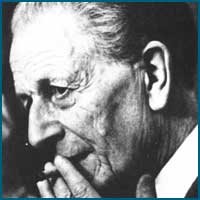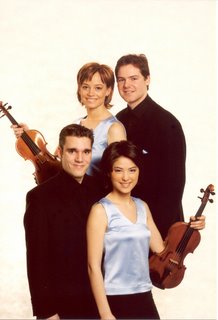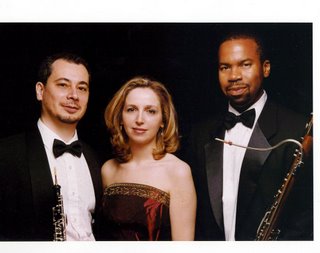From George A. Pieler, on a piano recital run (Peter Serkin, Yundi Li), comes this review of the Embassy Series' Reto Reichenbach recital.
The Embassy Series does yeoman work in bringing artists we should hear, but might otherwise miss, in comparatively intimate settings that inspire audience attention. Some of these settings by nature have less than ideal acoustics: Reto Reichenbach’s Friday recital at the Embassy of Switzerland showed us both sides of the coin.
Ann Schein student Mr. Reichenbach, Swiss-born and resident, has local ties through his studies at the Peabody Conservatory. In his early 30s, he is the very image of the serious concert pianist. He played well but not perfectly, but he deserves highest marks for his programming (nearly a lost art in my book): youthful works by Brahms, bracketed by the 8 Preludes of the great Swiss composer Frank Martin (Reichenbach is a bit of a 20th-century specialist), and by César Franck’s Prelude, Chorale, and Fugue.
Brahms dominated, including the late E-flat intermezzo (echt-late Brahms, nostalgic but tightly structured and well played here) offered as an encore. First up was Brahms’s op. 1, the C major sonata, one of the pieces that inspired Schumann-as-critic to launch the young composer on his path to fame. Op. 1 doesn’t get such a good critical reception these days, and that’s a shame: while the music has some of the flaws of youth (an indecisive finale, a bit too much repetition of thematic material) it has youth’s virtues as well. The music is bold and impetuous, the opening Allegro built on an insistent and persuasive rhythmic pattern that holds the movement together nicely, a folk-inspired Andante, and a Scherzo with clear pre-echoes of the comparable movement in the F minor piano quintet. It is unmistakably Brahms, although non-obvious comparisons come to mind — the bold rhythmic patterning and dramatic pauses of the opening movement almost remind one of — bear with me here — early Bruckner.
It’s good music, and it was effectively played by Mr. Reichenbach, if without ultimate finesse. Here and throughout the program there was the occasional dropped note, not too distracting but more than one wants to hear. I don’t know how long he has had this work in his repertoire and suspect he can present it with more dramatic impact than he did on Friday. My enjoyment may also have been hampered by a rather dry (and at times) boxy sound from his Steinway (instrument of the house, one presumes).
More Brahms, complete with thunderstorm pyrotechnics, after the brief interval: Variations on an Original Theme, op. 21, no. 1. While early, this music is more what people think of in terms of Brahms-and-piano: nostalgic, well-crafted, most effective in the slow concluding variations, not highly memorable but pleasant. Again Mr. Reichenbach did well but didn’t sell the music as strongly as he might.
Last but not least the Franck, the best performance of the evening. Mr. Reichenbach has a real feel for this music, which can sound like a suite of unrelated pieces. He stressed its thematic and stylistic unity, played fluently and gracefully, and drove home the final tintinnabulations of the Fugue with dramatic flair. All signs that he may be more in touch with the French side of his Swiss heritage than the German. Even the piano sounded fuller and more pleasing in this music.
I’ve mentioned Reto Reichenbach’s courageous and original programming, of which other recitalists of greater and lesser repute should take note. That brings me to the Martin Preludes, in many ways the most interesting music on the program and a fine opportunity to propagandize for Frank Martin, easily on my ‘top 20’ of 20th-century composers.
 First, the 8 Preludes themselves, fully mature Martin from 1948 and his most significant composition for piano. The sequence forms a kind if rising arc of increasingly complexity (for both performer and listener), culminating for this listener in the Lento No. 7, the longest of the preludes and finely rendered by Reichenbach. The concluding Vivace will remind Martin aficionados of the conclusion of the Petite Symphonie Concertante, quick, bouncy, irrepressible yet refined, at times rather like a bunch of frogs jumping about - yet with elegance!
First, the 8 Preludes themselves, fully mature Martin from 1948 and his most significant composition for piano. The sequence forms a kind if rising arc of increasingly complexity (for both performer and listener), culminating for this listener in the Lento No. 7, the longest of the preludes and finely rendered by Reichenbach. The concluding Vivace will remind Martin aficionados of the conclusion of the Petite Symphonie Concertante, quick, bouncy, irrepressible yet refined, at times rather like a bunch of frogs jumping about - yet with elegance!
For a composer who neglected the piano, it surprises how much the preludes convey Martin’s style, with a calculated tonal uncertainty (Martin admired 12-tone theory but took what he wanted from it and left the ideology behind) combined with shifting rhythms to create an almost mystic poignancy at times. Such music difficult to describe and best be heard.
The Preludes are available, either on Gall records with Daniel Spiegelberg's recording of the complete Martin solo piano works, as part of a recital by Diane Walsh on Bridge, on a disc of Preludes with Yoko Kikuchi or, if you are in Australia, buy Julie Adam and Christine Logan’s recording on ABC.
If you don’t yet know Frank Martin’s music at all, you ought to, and the piano works, though fine, are not the place to start. While Martin’s music is seldom heard locally, I was glad to hear his Ariel Songs performed by the Ensemble Corund at the Library of Congress, and they’re available from The Sixteen in a fine compilation including Martin’s Mass for Double Choir, probably his ‘greatest hit’ and sometimes performed in the D.C. area. The Gramophone award-winning Westminster Choir version of the Mass on Hyperion (coupled with Pizzetti) also is worth looking into; the Robert Shaw version on Telarc, a performance with merit if somewhat bland, comes with interesting couplings by Gorecki, Pärt, Barber, and Schoenberg.
If you are with me this far, you will also want to sample Martin’s orchestral music: fortunately there are no less-than-acceptable recordings (including the composer’s own, despite dated sound), but a fine and inexpensive place to start is with Armin Jordan’s Warner disc including the Petite Symphonie Concertante (Martin’s masterpiece…I think).
One hopes indeed that the Embassy of Switzerland might advocate more for their native son — perhaps partnering with other fine local performing organizations to sponsor a performance of Martin’s opera Der Sturm (The Tempest) as a challenge to the Kennedy Center’s pedestrian Shakespeare Festival planned for next year. In the meantime if you want Martin for Easter week, hear his Golgotha, blessed by a number of good recordings, the best value being the bargain Brilliant Classics version.




































































